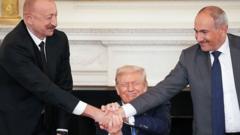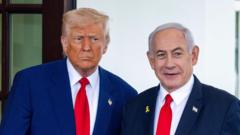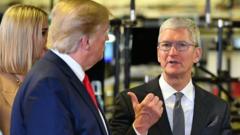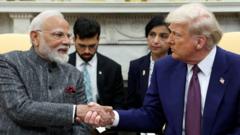**As the deadline was approaching for increased tariffs, both nations agreed to a 90-day extension, indicating positive dialogue on complex trade issues.**
**US and China Trade Talks Progress with Extended Tariff Truce**

**US and China Trade Talks Progress with Extended Tariff Truce**
**In a last-minute decision, the US and China have extended their trade tariff truce to stave off economic disruptions.**
The ongoing trade truce between the United States and China has been extended for 90 days, just hours before a significant increase in tariffs was scheduled to take effect. This decision, made through an executive order by US President Donald Trump, preserves a prior agreement reached in May, where both countries temporarily halted some of their tariffs.
The looming deadline prompted US officials to express the necessity of extending the truce, as higher tariffs were set to be enforced the following day. This latest development comes on the heels of productive discussions that took place last month, with negotiators from both nations describing the meetings as “constructive.” The lead Chinese negotiator emphasized a commitment to maintaining the truce, while US representatives awaited final approval from Trump.
If the increase in tariffs had gone ahead, it could have triggered a new wave of economic instability and uncertainty. Trade relations between the US and China intensified dramatically in April, when President Trump proposed extensive tariffs on a range of global imports, with China being particularly affected. In response, Beijing retaliated with its own set of tariffs, resulting in a heated exchange that drove tariffs to unprecedented levels, nearly halting bilateral trade.
The existing agreement, while extending the truce, still means that Chinese goods entering the US face an additional tariff of 30% from the start of the year, while American exports to China are subjected to a 10% tariff. Ongoing discussions encompass critical topics like China's access to rare earth elements, the country's oil purchases from Russia, and US restrictions on advanced technology exports to China, including semiconductor chips. Recent developments saw Trump ease some restrictions, allowing companies like AMD and Nvidia to resume chip sales to Chinese firms under specific revenue-sharing conditions.
Moreover, the US continues to advocate for the divestment of TikTok from its Chinese parent company, ByteDance, a move that has met resistance from China. In a press briefing earlier this week, Trump indicated that relationships between the two countries have been improving but refrained from confirming the extension of the truce. Just a day prior, he urged China to bolster its imports of American soybeans.
Despite the truce, trade between the two nations has suffered significantly this year. Government statistics reveal that US imports from China decreased by nearly 50% in June compared to the same month in 2024, resulting in a total of $165 billion worth of goods imported from China in the first half of this year—a 15% decline year-on-year. Conversely, American exports to China have dipped by approximately 20% during the same timeframe.
The looming deadline prompted US officials to express the necessity of extending the truce, as higher tariffs were set to be enforced the following day. This latest development comes on the heels of productive discussions that took place last month, with negotiators from both nations describing the meetings as “constructive.” The lead Chinese negotiator emphasized a commitment to maintaining the truce, while US representatives awaited final approval from Trump.
If the increase in tariffs had gone ahead, it could have triggered a new wave of economic instability and uncertainty. Trade relations between the US and China intensified dramatically in April, when President Trump proposed extensive tariffs on a range of global imports, with China being particularly affected. In response, Beijing retaliated with its own set of tariffs, resulting in a heated exchange that drove tariffs to unprecedented levels, nearly halting bilateral trade.
The existing agreement, while extending the truce, still means that Chinese goods entering the US face an additional tariff of 30% from the start of the year, while American exports to China are subjected to a 10% tariff. Ongoing discussions encompass critical topics like China's access to rare earth elements, the country's oil purchases from Russia, and US restrictions on advanced technology exports to China, including semiconductor chips. Recent developments saw Trump ease some restrictions, allowing companies like AMD and Nvidia to resume chip sales to Chinese firms under specific revenue-sharing conditions.
Moreover, the US continues to advocate for the divestment of TikTok from its Chinese parent company, ByteDance, a move that has met resistance from China. In a press briefing earlier this week, Trump indicated that relationships between the two countries have been improving but refrained from confirming the extension of the truce. Just a day prior, he urged China to bolster its imports of American soybeans.
Despite the truce, trade between the two nations has suffered significantly this year. Government statistics reveal that US imports from China decreased by nearly 50% in June compared to the same month in 2024, resulting in a total of $165 billion worth of goods imported from China in the first half of this year—a 15% decline year-on-year. Conversely, American exports to China have dipped by approximately 20% during the same timeframe.





















